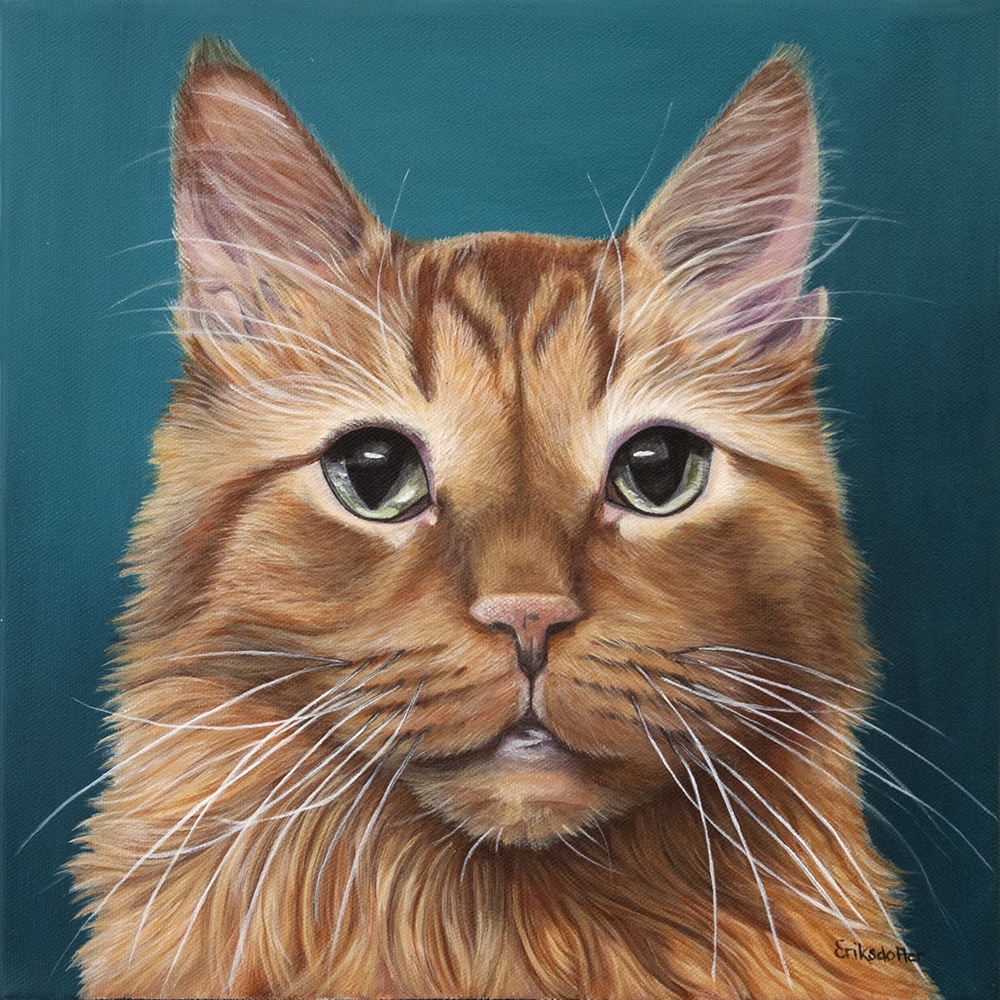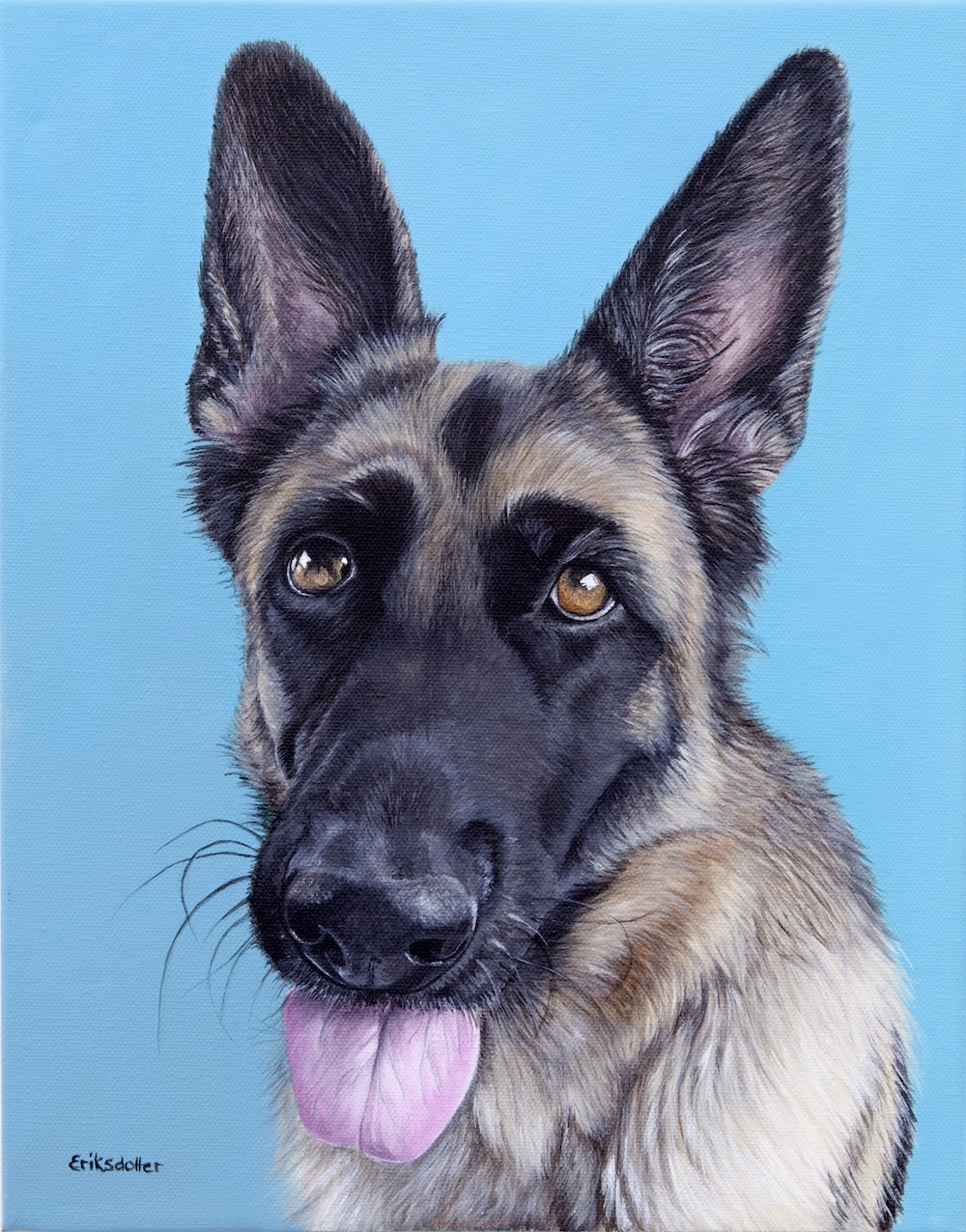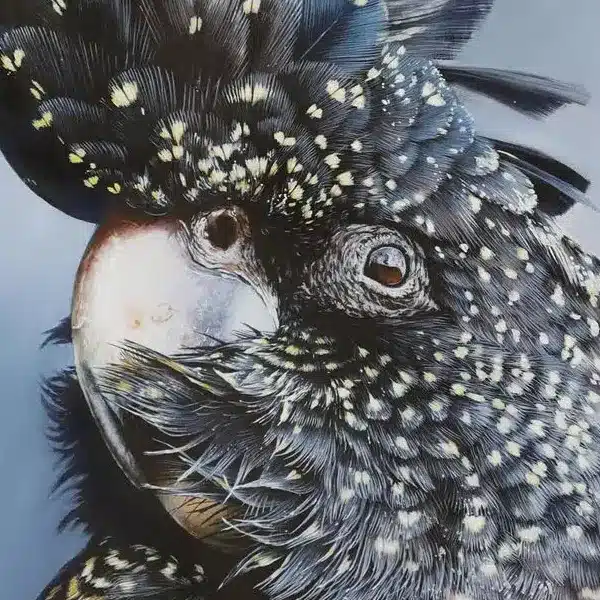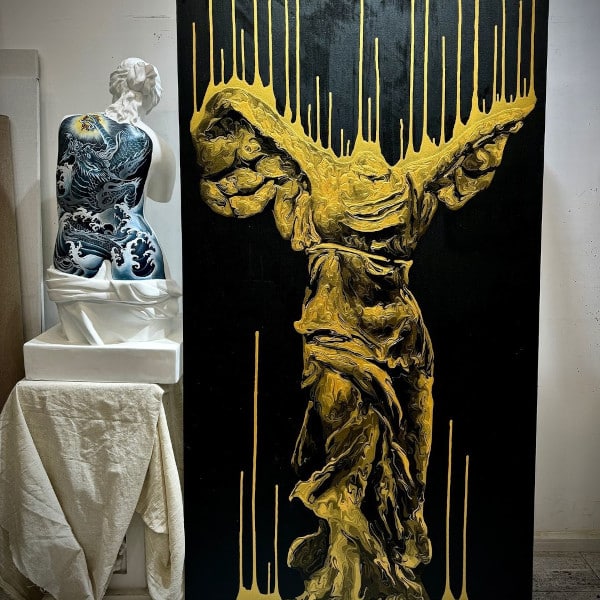
Artist Erica Eriksdotter‘s life has been full of evolution. Born and raised in Sweden, she moved to the United States in her 20s to continue her studies. An avid painter from childhood, her love of watercolors transformed into the use of thin layers of acrylic paint. It was this breakthrough, that occurred while she was working full-time in public relations, that caused her to step away from one career and move toward another.
Now a full-time artist, she specializes in commissioned paintings—particularly pet portraits to immortalize the love between owners and their furry friends. This knack for capturing the spirit of cats and dogs is informed by Eriksdotter's own experiences with her beloved animals. Now, she has a long waiting list of clients who seek out her talent in memorializing a lost pet or immortalizing their four-legged family member.
Eriksdotter's journey from a career in PR to full-time freelance artist—all while juggling a family—is a courageous one. Her ability to follow her instincts and hone her craft speak to her tenacious spirit, which has paid off with a successful and satisfying career in the arts.
We had the chance to speak with Eriksdotter about her love for painting, what she enjoys loves about creating pet portraits, and how she knew the time was right to make the leap to freelancing. Read on for My Modern Met’s exclusive interview.

When did your love affair with art begin and was it a constant through your life?
There was never really a starting point with my art, there just was. Painting has always been an essential way of being for me, whether it was finishing watercolor pieces while on the phone with girlfriends in my teens, or working on large acrylic statement pieces to exhibit in National Juried Art shows on the East Coast in my 20s and 30s.
While the love affair with art has been constant, there have been times when it felt more of a resistance when painting. I knew what my heart wanted to put on the canvas, but it just didn’t flow for me. It was when I revisited acrylics again after years of working solely with watercolors that it just clicked for me. I played around and blended the paint heavily with water, and suddenly it was like a mix of watercolor and acrylic. It matched me. Finally, the bubbling creative feeling from within matched what came out on the canvas. Over 100 commissions later, I still use the same technique.

You were working in public relations. How did you balance this and your art?
I basically had two full-time jobs for over a decade. I’d come home after a long day in PR and sit in the studio finishing custom paintings or statement pieces for an upcoming art show. I spent 20 to 30 hours every week honing my skills with one painting after another. For several years my husband and I also traveled up and down the East Coast participating in National Juried Art shows on the weekends. I knew I needed to push myself to make it work. For me, there was no other choice—I had to paint.
It was in my mid-twenties that people started commissioning me to paint statement pieces to add culture and meaning to their homes. That’s when I thought to myself… maybe this could work one day.

Leaving behind one career for another is tough. When did you know it was time to make the leap into full-time art and how did you prepare yourself for it?
It wasn’t easy to make a life-changing decision that impacted not only myself but also my husband and my—at the time—one-year-old child. After giving birth, my time became even more precious to me. Not only what I spent my time doing, but also how and with whom. I noticed how even more nurturing and fulfilling my time in the studio became, and how rewarding time as a mom was.
While it wasn’t an easy decision, it was a natural step for our family to give it a try. One of my favorite expressions as an entrepreneur is “eff it, it’ll work out” in regards to taking chances and braving all sorts of situations. I had spent more than 30 years of my life painting and, for several of those years, with a waitlist. That didn't mean it would work, but it meant I knew myself, my work, and already a list of wonderful customers who would help me spread the word about my art.

What was your first pet portrait and what drew you to painting animals?
Our stray cat Lola has been instrumental in my decision to try my hands at painting animals. I never dared painting animals as a young painter because I knew how important those eyes are. They’re the window to the soul and if you can’t get those right, the animal has no spirit on canvas.
She came to our patio as a stray in 2009, and she often lies in my lap while I paint, biting my paintbrush or getting wet paint on her fluffy tail. She knows when I’m sad or wake up from a bad dream in the middle of the night. Before I had children, she and I would cuddle all night. It was her soulful eyes that made me dare to ask my customers for photos of their pets to let me practice on.
Before Lola, I grew up with a Yorkie who was always by my side. I think that’s why I understand my customers so well—20 years later and I can still break down and sob over losing him. He was my everything. To me, it was too emotional to practice on him so I asked my customers if they could share some of their photos of their beloved pets instead. They loved the results and people started commissioning pet portraits.

Can you take us through your creative process in capturing the spirit of a dog or cat you are commissioned to paint?
I ask my customers to provide me with photos of their animal, which often includes long emotional emails filled with tales of love and loss. I love those emails. I review the photos and “tap into” their furry friend’s likeness and personality. I let the pet’s character come to me.
I loosely sketch out the pet and then it’s time for the first paint layer. I choose the paint tubes, mix the colors, fill the painting water, and pick my brushes. I start with the eyes. Once I’m happy with where the eyes are, I start on the rest of the face and gradually work my way out. I may apply several layers to one area, like an ear, before moving on to another area, like the neck.

(continued) Every pet painting comes alive through many, many thin layers of watered down acrylic paint. After many, many hours on a pet, my favorite part arrives—the details! Each layer includes more and more details with smaller and smaller brushes, some no wider than two millimeters. I spend a long time applying details and painting thin hairs and I love every moment I get with these amazing animals.
Once I’m pretty far along with the animal, I brainstorm the background color with the customer before applying it and continuing to fine-tune the portrait. I enjoy documenting the process via Instagram where people can see snapshots from the studio and watch me paint.

What's the most challenging part, as an artist, about being commissioned to capture the likeness of a beloved pet?
The most challenging part isn’t that people come to me with the big task of having me paint what may be the one thing they’ve loved the most in their life. It isn’t the emotional emails the customer and I exchange about their beloved animal. Nor is it to say goodbye to every pet portrait that I’ve spent 40 to 80 hours with in the studio once it’s finished. The most challenging part with a commission is that blank canvas that is staring back at me at the beginning of every painting waiting for me to make the first move.

Is there one particular commission that stands out to you?
It’s the stories of how much these pets meant—or mean—to their parents that stay with me. Those long emails that we exchange about how they may have rescued their dog and spent the next 10 years doing everything together, or how the cat that lived for 23 years slept on her parents' pillow every night.
I truly feel so honored to do this work, especially after they’ve seen the portrait in real life, or they’ve surprised a loved one and seen them open their meaningful gift. I hold my breath reading countless love notes I receive of how healing the portrait is to them and how much meaning it brings to their home.

What's the most satisfying part of your work?
Many customers have lost their pets, and this experience becomes a place of healing for them. From start to finish, it’s a journey through grief as they see their darling sweetheart come alive on canvas through photos, videos, and even live painting on my Instagram. Many cry when they see the finished portrait for the first time—it’s a deeply moving and healing experience. To know that I have a part in bringing healing to their heartache is the most satisfying part, and that’s how I chose to serve.

What's the most challenging part of your work as a freelancer?
I’m also a professional juggler of a 3-year-old and a 4-month-old, as well as a freelancer which makes life quite interesting. Without childcare, it’s a bit tricky sometimes to make the schedule work, but it’s also my favorite thing (as long as it does eventually work out!). Luckily, my mother has helped me out immensely. Without her, this wouldn’t have worked.

What do you hope that people take away from your story?
I truly love what I do, and doing what I love makes me whole. An Instagram follower recently said on a post of mine: “Your compassion for others runs deep.” I consider it an honor to bring joy and healing to others through color and thrive on collaborating with them as they move through grief because it nurtures and fulfills me too. I’m grateful to serve in this way, and I think customers recognize that these portraits are a place of healing, full of love and joy, and don’t mind waiting more than a year to have one.
Looking back at my life, I can see the stepping stones that got me here: my supportive family, losing Lucas—my darling dog as a teenager— and soon thereafter my father, moving to a different continent, daring to exhibit and later doing many art shows, saying yes to commissions, trying new things, etc. but the main stone, the big rock that got me here is that I kept showing up for myself. No matter the ups and downs and the things that felt like failures at the time, I consistently pushed myself and kept honing my craft every day. Every painting I finish in the studio today is a culmination of all those 30 years.























































































